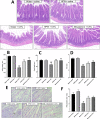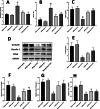Protective effect of homogeneous polysaccharides of Wuguchong (HPW) on intestinal mucositis induced by 5-fluorouracil in mice
- PMID: 35585561
- PMCID: PMC9118848
- DOI: 10.1186/s12986-022-00669-1
Protective effect of homogeneous polysaccharides of Wuguchong (HPW) on intestinal mucositis induced by 5-fluorouracil in mice
Abstract
Background: In hospitalized patients, drug side effects usually trigger intestinal mucositis (IM), which in turn damages intestinal absorption and reduces the efficacy of treatment. It has been discovered that natural polysaccharides can relieve IM. In this study, we extracted and purified homogenous polysaccharides of Wuguchong (HPW), a traditional Chinese medicine, and explored the protective effect of HPW on 5-fluorouracil (5-FU)-induced IM.
Methods and results: First, we identified the physical and chemical properties of the extracted homogeneous polysaccharides. The molecular weight of HPW was 616 kDa, and it was composed of 14 monosaccharides. Then, a model of small IM induced by 5-FU (50 mg/kg) was established in mice to explore the effect and mechanism of HPW. The results showed that HPW effectively increased histological indicators such as villus height, crypt depth and goblet cell count. Moreover, HPW relieved intestinal barrier indicators such as D-Lac and diamine oxidase (DAO). Subsequently, western blotting was used to measure the expression of Claudin-1, Occludin, proliferating cell nuclear antigen, and inflammatory proteins such as NF-κB (P65), tumour necrosis factor-α (TNF-α), and COX-2. The results also indicated that HPW could reduce inflammation and protect the barrier at the molecular level. Finally, we investigated the influence of HPW on the levels of short-chain fatty acids, a metabolite of intestinal flora, in the faeces of mice.
Conclusions: HPW, which is a bioactive polysaccharide derived from insects, has protective effects on the intestinal mucosa, can relieve intestinal inflammation caused by drug side effects, and deserves further development and research.
Keywords: 5-Fluorouracil; Drug side effects; Intestinal barrier; Intestinal mucositis; Polysaccharide; Wuguchong.
© 2022. The Author(s).
Conflict of interest statement
The authors declare that they have no competing interests.
Figures






Similar articles
-
The protective effects of Aquilariae Lignum Resinatum extract on 5-Fuorouracil-induced intestinal mucositis in mice.Phytomedicine. 2019 Feb 15;54:308-317. doi: 10.1016/j.phymed.2018.07.006. Epub 2018 Jul 20. Phytomedicine. 2019. PMID: 30396718
-
Carboxymethyl pachyman (CMP) reduces intestinal mucositis and regulates the intestinal microflora in 5-fluorouracil-treated CT26 tumour-bearing mice.Food Funct. 2018 May 23;9(5):2695-2704. doi: 10.1039/c7fo01886j. Food Funct. 2018. PMID: 29756138
-
Protective effect of Bu-Zhong-Yi-Qi decoction, the water extract of Chinese traditional herbal medicine, on 5-fluorouracil-induced intestinal mucositis in mice.Hum Exp Toxicol. 2016 Dec;35(12):1243-1251. doi: 10.1177/0960327115627686. Epub 2016 Jan 22. Hum Exp Toxicol. 2016. PMID: 26801985
-
Lentinan's effect on gut microbiota and inflammatory cytokines in 5-FU-induced mucositis mice.AMB Express. 2025 Jan 22;15(1):11. doi: 10.1186/s13568-024-01796-z. AMB Express. 2025. PMID: 39843881 Free PMC article.
-
Patchouli oil ameliorates 5-fluorouracil-induced intestinal mucositis in rats via protecting intestinal barrier and regulating water transport.J Ethnopharmacol. 2020 Mar 25;250:112519. doi: 10.1016/j.jep.2019.112519. Epub 2019 Dec 25. J Ethnopharmacol. 2020. PMID: 31883475
Cited by
-
Extraction of polysaccharides from Maca enhances the treatment effect of 5-FU by regulating CD4+T cells.Heliyon. 2023 May 24;9(6):e16495. doi: 10.1016/j.heliyon.2023.e16495. eCollection 2023 Jun. Heliyon. 2023. PMID: 37274637 Free PMC article.
-
Dietary restriction rescues 5-fluorouracil-induced lethal intestinal toxicity in old mice by blocking translocation of opportunistic pathogens.Gut Microbes. 2024 Jan-Dec;16(1):2355693. doi: 10.1080/19490976.2024.2355693. Epub 2024 May 23. Gut Microbes. 2024. PMID: 38780487 Free PMC article.
-
The Protective Effects of Lactobacillus reuteri Combined With Clostridium butyricum Miyairi 588 on Intestinal Barrier Function, Water Transport, and Oxidative Stress in a Rat Model of 5FU-Induced Diarrhea.Food Sci Nutr. 2025 May 23;13(6):e70318. doi: 10.1002/fsn3.70318. eCollection 2025 Jun. Food Sci Nutr. 2025. PMID: 40444121 Free PMC article.
-
Protective effects of the bioactive peptide from maggots against skin flap ischemia‒reperfusion injury in rats.Heliyon. 2024 Apr 18;10(9):e29874. doi: 10.1016/j.heliyon.2024.e29874. eCollection 2024 May 15. Heliyon. 2024. PMID: 38694094 Free PMC article.
-
Network analysis and experimental pharmacology study explore the protective effects of Isoliquiritigenin on 5-fluorouracil-Induced intestinal mucositis.Front Pharmacol. 2022 Oct 6;13:1014160. doi: 10.3389/fphar.2022.1014160. eCollection 2022. Front Pharmacol. 2022. PMID: 36278232 Free PMC article.
References
-
- Soares PM, Mota JM, Gomes AS, Oliveira RB, Assreuy AM, Brito GA, Santos AA, Ribeiro RA, Souza MH. Gastrointestinal dysmotility in 5-fluorouracil-induced intestinal mucositis outlasts inflammatory process resolution. Cancer Chemother Pharmacol. 2008;63(1):91–8. - PubMed
Grants and funding
LinkOut - more resources
Full Text Sources
Research Materials

